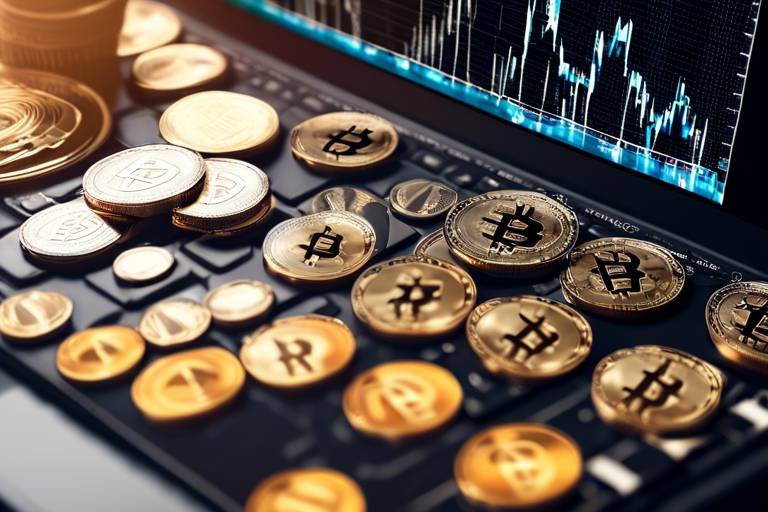Understanding Liquidity Pools in Decentralized Exchanges
In the ever-evolving landscape of cryptocurrency, the term liquidity pools has become a buzzword, especially in the context of decentralized exchanges (DEXs). But what exactly are liquidity pools, and why should you care? Imagine a vast ocean where multiple traders can dip in and out, exchanging their assets without the constraints of traditional financial systems. This is the essence of liquidity pools. They serve as reservoirs of funds that facilitate seamless trading, enabling users to swap tokens directly without the need for intermediaries. It's a game-changer for anyone looking to dive into the world of crypto trading.
At their core, liquidity pools are collections of funds locked within smart contracts that allow users to trade assets effortlessly. Unlike traditional exchanges that rely on order books, where buyers and sellers must match, liquidity pools aggregate funds from multiple users, creating a shared resource for trading. This innovative approach not only enhances trading efficiency but also ensures that there is always liquidity available for users. Think of it as a communal pot where everyone contributes, and in return, they can access a wealth of trading opportunities at any time.
So, how do these liquidity pools actually function? They operate through sophisticated smart contracts that hold the pooled funds. When a user wants to swap one token for another, they interact directly with the smart contract. This eliminates the need for a middleman, streamlining the entire trading process. Imagine ordering your favorite pizza directly from the chef rather than going through a delivery service; it’s faster and often cheaper! By directly engaging with smart contracts, users can enjoy a more efficient trading experience.
Enter the world of Automated Market Makers (AMMs), the algorithms that power liquidity pools. These clever systems determine the price of assets in real-time, ensuring that trades can occur automatically. Rather than waiting for a buyer or seller to match your order, AMMs continuously adjust prices based on supply and demand. It’s like having a personal assistant who knows exactly when to buy or sell to get you the best deal. This automated approach not only makes trading faster but also helps maintain a stable market.
AMMs utilize various pricing algorithms to establish token prices, with one of the most common being the constant product formula. This formula ensures that the product of the quantities of the two tokens in the pool remains constant, which in turn helps to minimize slippage during trades. Let’s break it down with a simple analogy: if you have a fixed amount of lemonade and water in a pitcher, changing the ratio of lemonade to water affects the overall flavor. Similarly, AMMs balance token values to provide a smooth trading experience.
There are several compelling reasons to embrace AMMs in the world of decentralized exchanges:
- Reduced Transaction Times: Trades happen almost instantly, thanks to the automated nature of AMMs.
- Lower Fees: Without intermediaries, users often face significantly lower transaction costs.
- Enhanced Accessibility: Anyone can become a liquidity provider, democratizing the trading landscape.
These benefits make AMMs an attractive option for both novice and experienced traders alike, fostering a more inclusive trading environment.
Now, let’s talk about the heroes of liquidity pools: the liquidity providers. These are the users who contribute their assets to the pools, enabling others to trade. In return for their contributions, liquidity providers earn rewards in the form of transaction fees generated by the trades that occur within the pool. It’s like being a landlord who rents out space and collects rent; the more you contribute, the more you earn. This incentivization is crucial for maintaining liquidity and ensuring that traders have access to the assets they need.
While liquidity pools offer exciting opportunities, they are not without risks. Potential liquidity providers should be aware of issues like impermanent loss and smart contract vulnerabilities. Understanding these risks is essential for anyone looking to participate in the liquidity pool ecosystem.
Impermanent loss occurs when the value of the tokens you have deposited in a liquidity pool changes compared to simply holding them in a wallet. If the price of one of the tokens increases significantly, you might end up with less value than if you had just held onto it. It’s akin to selling your favorite collectible at a garage sale just before it skyrockets in value. While impermanent loss can be mitigated through careful strategy and market awareness, it’s crucial to be informed about this phenomenon before diving in.
Smart contracts, while revolutionary, can also be vulnerable to bugs and exploits. They are complex pieces of code that govern the operations of liquidity pools, and any flaws can lead to significant losses. Therefore, conducting thorough research before participating in any liquidity pool is vital. It’s like checking the safety ratings before booking a vacation rental; you want to ensure your investment is secure.
As we wrap up our exploration of liquidity pools, you might have a few lingering questions. Here are some of the most common:
- What is a liquidity pool? A liquidity pool is a collection of funds locked in a smart contract that allows users to trade assets without relying on traditional order books.
- How do I become a liquidity provider? You can become a liquidity provider by depositing your assets into a liquidity pool on a decentralized exchange.
- What are the risks of liquidity pools? The primary risks include impermanent loss and vulnerabilities in smart contracts.

The Concept of Liquidity Pools
Liquidity pools are the beating heart of decentralized exchanges (DEXs), serving as essential components that allow for seamless trading experiences. Imagine walking into a bustling marketplace where you can buy and sell goods without waiting for someone to match your order. This is precisely what liquidity pools enable in the digital asset world. By aggregating funds from multiple users, liquidity pools provide the necessary liquidity that facilitates continuous trading without the need for traditional order books.
At their core, liquidity pools consist of smart contracts that hold a collection of tokens. When users want to trade, they interact directly with these smart contracts instead of relying on a centralized authority. This innovative approach not only enhances the speed of transactions but also democratizes access to trading. Users can join these pools by depositing their tokens, effectively contributing to the overall liquidity available for trading pairs. This collective effort ensures that anyone looking to swap tokens can do so swiftly and efficiently.
To further illustrate, let’s break down the concept of liquidity pools into a few key elements:
- Decentralization: Liquidity pools operate without a central authority, allowing users to trade directly with each other.
- Accessibility: Anyone can become a liquidity provider by depositing tokens into the pool, making it easy for all participants to engage in trading.
- Continuous Trading: With liquidity pools, trading can happen 24/7, providing users with the flexibility to execute trades at any time.
In summary, liquidity pools are a revolutionary concept that transforms how we think about trading assets in the cryptocurrency space. They eliminate the barriers imposed by traditional exchanges, allowing for a more inclusive and efficient trading environment. As we delve deeper into how liquidity pools work, you'll see how they utilize automated market makers (AMMs) to maintain balance and ensure that trading can occur seamlessly.

How Liquidity Pools Work
Liquidity pools are a fascinating innovation in the world of decentralized finance (DeFi). They work by utilizing smart contracts—self-executing contracts with the terms of the agreement directly written into code. When users want to swap one token for another, they interact with these smart contracts, which hold the pooled assets. This mechanism allows for direct token swaps without the need for traditional order books, which can often be slow and cumbersome. Imagine a bustling marketplace where buyers and sellers can trade directly without waiting in line; that’s the magic of liquidity pools.
At their core, liquidity pools aggregate funds from multiple users, creating a large pool of assets that can be accessed by anyone looking to trade. This aggregation is not only beneficial for traders, who enjoy seamless transactions, but it also empowers liquidity providers—individuals who contribute their tokens to the pool. In return for providing liquidity, these users earn a share of the transaction fees generated from trades that occur within the pool. It’s a win-win scenario where traders benefit from instant liquidity, and liquidity providers earn rewards for their contributions.
When a user initiates a trade, the smart contract automatically calculates the amount of tokens to swap based on the current liquidity available in the pool. This is done through a pricing mechanism known as the Automated Market Maker (AMM). The AMM uses algorithms to adjust the prices of tokens based on supply and demand, ensuring that the pool remains balanced. For example, if a lot of a particular token is being sold, the AMM will increase its price, making it less attractive to sell more, while simultaneously making the other token in the pool cheaper to buy. This dynamic pricing helps maintain equilibrium in the market.
Furthermore, the efficiency of liquidity pools is enhanced by the concept of impermanent loss, which is an important factor to consider for liquidity providers. When the prices of the tokens in the pool fluctuate, the value of the assets in the pool can diverge from simply holding those assets in a wallet. This can lead to lower returns for liquidity providers over time. However, the potential for earning transaction fees often compensates for this risk, making it an appealing venture for many.
To illustrate how liquidity pools function, consider the following table that outlines the key components:
| Component | Description |
|---|---|
| Liquidity Pool | A collection of funds from multiple users, enabling token swaps. |
| Smart Contract | Code that automates the trading process and holds the pooled assets. |
| Automated Market Maker (AMM) | Algorithm that determines token prices based on supply and demand. |
| Liquidity Provider | User who contributes tokens to the pool and earns transaction fees. |
In conclusion, liquidity pools revolutionize the way we think about trading in the DeFi space. They eliminate the need for intermediaries, reduce transaction costs, and provide users with a seamless trading experience. As the world of decentralized exchanges continues to grow, understanding how liquidity pools work will be key for anyone looking to navigate this exciting landscape.
What is a liquidity pool?
A liquidity pool is a collection of funds from multiple users that allows for the trading of tokens without relying on traditional order books.
How do liquidity providers earn money?
Liquidity providers earn a share of the transaction fees generated from trades that occur within the liquidity pool.
What are the risks associated with liquidity pools?
Risks include impermanent loss, where the value of tokens changes relative to holding them, and smart contract vulnerabilities that could lead to loss of funds.

Role of Automated Market Makers (AMMs)
The emergence of Automated Market Makers (AMMs) has revolutionized the way we think about trading in decentralized exchanges (DEXs). Unlike traditional exchanges that rely on order books and market makers, AMMs use algorithms to facilitate trades. This means that instead of waiting for a buyer and seller to match their orders, users can swap tokens directly through smart contracts. Isn’t that a game-changer? By eliminating the need for intermediaries, AMMs create a more efficient trading environment that is accessible to everyone.
AMMs operate on the principle of liquidity pools, where users can deposit their tokens and contribute to the overall liquidity of the exchange. When you think about it, it’s a bit like pooling resources in a community pot. The more liquidity there is, the easier it is for traders to make transactions without experiencing significant price fluctuations. This is especially important in a volatile market where every second counts.
At the core of AMMs is a pricing mechanism that adjusts automatically based on supply and demand. This dynamic pricing ensures that trades can happen seamlessly. For instance, if a trader wants to swap Token A for Token B, the AMM algorithm calculates the price based on the existing liquidity in the pool. This is often done using formulas like the constant product formula, which keeps the product of the quantities of the two tokens constant. So, if you add more of one token to the pool, the price of that token will decrease, while the price of the other token increases. It’s a delicate balance that keeps everything running smoothly.
One of the most exciting aspects of AMMs is that they democratize trading. Anyone can become a liquidity provider by depositing their tokens into a pool. This opens up opportunities for individuals who may not have had access to traditional trading platforms. Plus, liquidity providers earn a share of the transaction fees generated by the trades that occur in their pool. It's like getting paid for contributing to a community fund!
In summary, the role of AMMs in decentralized exchanges cannot be overstated. They not only facilitate trades without intermediaries but also incentivize users to contribute to liquidity pools, ensuring that the marketplace remains vibrant and accessible. As we continue to explore the world of decentralized finance, understanding how AMMs function will be crucial for anyone looking to navigate this new frontier.
- What are Automated Market Makers (AMMs)? AMMs are algorithms that facilitate trading in decentralized exchanges by allowing users to swap tokens directly through liquidity pools.
- How do AMMs determine prices? AMMs use various pricing algorithms, such as the constant product formula, to maintain a balance between supply and demand.
- Can anyone become a liquidity provider? Yes! Anyone can provide liquidity by depositing tokens into a liquidity pool and earn transaction fees in return.
- What are the risks associated with AMMs? Risks include impermanent loss and potential vulnerabilities in smart contracts, so it's important to do thorough research before participating.

Pricing Mechanisms in AMMs
Pricing mechanisms in Automated Market Makers (AMMs) are the backbone of how trades are executed in decentralized exchanges. Unlike traditional exchanges that rely on order books, AMMs utilize algorithms to determine the price of assets based on the available liquidity in the pool. One of the most widely used pricing formulas is the constant product formula, which is defined by the equation x * y k. In this formula, x and y represent the quantities of two tokens in the pool, and k is a constant. This means that the product of the quantities of the two tokens must always remain the same, ensuring that as one token is bought, its price increases, while the price of the other token decreases.
To visualize this concept, consider a simple example: imagine a pool containing two tokens, Token A and Token B. If the pool has 100 Token A and 200 Token B, the constant k is 20,000 (100 * 200). If a trader decides to buy 10 Token A from the pool, the amount of Token B they would have to pay increases, affecting the overall price. This dynamic pricing ensures that liquidity remains available, but it also introduces the concept of slippage, which refers to the difference between the expected price of a trade and the actual price at which the trade is executed.
AMMs can also employ other pricing mechanisms, such as weighted pools or dynamic pricing models. In weighted pools, different tokens can have varying weights, allowing for more complex pricing strategies. For instance, a pool could be designed to hold 70% of Token A and 30% of Token B, which would influence how trades are priced based on the weight of each token. Dynamic pricing models, on the other hand, can adjust prices based on market conditions, demand, and other external factors, providing a more flexible approach to trading.
Ultimately, the choice of pricing mechanism in an AMM can significantly impact user experience. Traders must be aware of how these mechanisms work to make informed decisions and minimize slippage. The beauty of AMMs lies in their ability to provide liquidity and facilitate trading without the need for traditional market structures, but understanding the underlying pricing mechanisms is crucial for success in this innovative space.
- What is an AMM? An Automated Market Maker (AMM) is a type of decentralized exchange that uses algorithms to price assets in liquidity pools, allowing for automated trading without the need for order books.
- How do liquidity pools work? Liquidity pools aggregate funds from multiple users, enabling them to trade assets directly through smart contracts, eliminating the need for intermediaries.
- What is impermanent loss? Impermanent loss occurs when the value of tokens in a liquidity pool changes compared to holding them in a wallet, potentially leading to lower returns for liquidity providers.
- Are AMMs safe? While AMMs offer many advantages, they are not without risks, including smart contract vulnerabilities. Users should conduct thorough research before participating.

Benefits of Using AMMs
Automated Market Makers (AMMs) have revolutionized the way we think about trading and liquidity in decentralized exchanges. One of the most significant benefits of using AMMs is their ability to facilitate trades without the need for a traditional order book. This means that users can execute trades at any time, making the trading experience much more fluid and accessible.
Another major advantage is the reduced transaction times. In a conventional exchange, you often have to wait for a buyer or seller to match your order. However, AMMs utilize smart contracts that allow for instantaneous swaps between tokens. This not only saves time but also enhances the overall trading experience by minimizing the waiting period.
Cost efficiency is yet another perk. AMMs typically charge lower fees compared to centralized exchanges. This is largely because they eliminate the need for intermediaries, which can significantly reduce operational costs. Users can save money on each transaction, making it more appealing for frequent traders.
Moreover, AMMs democratize the trading landscape. Anyone can become a liquidity provider by simply depositing tokens into a liquidity pool. This opens the doors for a broader audience to participate in the market, allowing even those with limited capital to engage in trading activities. It's a bit like opening a community garden; everyone can contribute, and everyone benefits from the bounty.
Additionally, AMMs offer enhanced accessibility to various financial instruments. Users can trade a wide range of tokens that may not be available on traditional exchanges. This flexibility allows traders to explore new opportunities and diversify their portfolios without the constraints typically found in centralized platforms.
Furthermore, by participating as liquidity providers, users can earn rewards in the form of transaction fees. This incentivizes individuals to contribute to the liquidity pools, leading to a more robust trading environment. The more liquidity there is, the easier it becomes for everyone to execute trades without experiencing significant price fluctuations.
In summary, the benefits of using AMMs are numerous and impactful. From reduced transaction times and lower fees to increased accessibility and the opportunity for passive income, AMMs have truly transformed the trading landscape. As we continue to embrace this technology, it’s essential to understand how these systems work and the advantages they offer.
- What are Automated Market Makers? AMMs are algorithms that facilitate trading by automatically determining token prices and enabling direct swaps between assets.
- How do I become a liquidity provider? To become a liquidity provider, simply deposit your tokens into a liquidity pool on a decentralized exchange that utilizes AMMs.
- What are the risks of using AMMs? The primary risks include impermanent loss and vulnerabilities in smart contracts. It's vital to do your research before participating.
- Can I lose money by providing liquidity? Yes, there is a possibility of incurring losses, especially due to impermanent loss, which occurs when the value of your deposited tokens fluctuates compared to holding them.

Liquidity Providers and Rewards
In the world of decentralized exchanges (DEXs), liquidity providers play a crucial role that cannot be overstated. These individuals or entities contribute their assets to liquidity pools, allowing traders to execute swaps seamlessly. By doing so, they help maintain the ecosystem's fluidity, ensuring that users can buy and sell assets without significant delays. But what’s in it for these liquidity providers? Well, they are not just altruistically supporting the DEX; they are also rewarded for their contributions.
When liquidity providers add their assets to a pool, they earn rewards primarily through transaction fees. Every time a trade occurs within the liquidity pool, a small fee is charged. This fee is then distributed proportionally among all liquidity providers based on their share of the pool. The more liquidity you provide, the larger your slice of the pie when it comes to rewards. It’s like being a shareholder in a company; the more shares you own, the greater your dividends.
To give you a clearer picture of how rewards work, let’s consider a hypothetical example. Imagine a liquidity pool that charges a 0.3% transaction fee on trades. If a total of $1,000,000 worth of trades occurs in a day, that means $3,000 in fees is generated. If you own 10% of the liquidity pool, you would earn $300 in rewards just for providing liquidity. However, keep in mind that these figures can vary based on the trading volume and the specific DEX.
Additionally, some DEXs offer further incentives to liquidity providers in the form of native tokens. These tokens can be earned as part of liquidity mining programs, where users are rewarded for providing liquidity with the platform's own cryptocurrency. This not only enhances the earning potential for liquidity providers but also encourages them to hold onto these tokens, contributing to the platform's overall stability and growth.
However, it’s important to note that while the rewards can be enticing, they come with responsibilities. Liquidity providers must actively monitor their investments, as the crypto market can be highly volatile. Keeping an eye on the performance of the liquidity pool and understanding the dynamics of the assets involved is essential. After all, providing liquidity is not just about earning rewards; it’s also about managing risks effectively.
In summary, liquidity providers are the backbone of decentralized exchanges, and their rewards come from transaction fees and potential native tokens. By participating in liquidity pools, they not only earn passive income but also contribute to the overall health of the trading ecosystem. Just like a well-oiled machine, every provider plays a part in ensuring that everything runs smoothly. So, if you’re considering becoming a liquidity provider, make sure you do your homework and understand both the rewards and risks involved!
- What is a liquidity provider? A liquidity provider is an individual or entity that supplies assets to a liquidity pool in a decentralized exchange, enabling seamless trading.
- How do liquidity providers earn rewards? They earn rewards primarily through transaction fees generated from trades within the liquidity pool.
- What is impermanent loss? Impermanent loss refers to the potential loss a liquidity provider may experience when the value of deposited tokens changes compared to holding them in a wallet.
- Are there risks associated with being a liquidity provider? Yes, risks include impermanent loss and vulnerabilities in smart contracts. It's essential to conduct thorough research before participating.

Risks Associated with Liquidity Pools
While liquidity pools have revolutionized the way we trade assets in the decentralized finance (DeFi) space, it's crucial to acknowledge that they come with their own set of risks. Understanding these risks can help you navigate the waters of DeFi more safely and make informed decisions. One of the most significant risks is impermanent loss, which occurs when the value of the tokens you deposit into a liquidity pool fluctuates compared to holding those tokens in your wallet. Imagine you have two tokens in a pool, and their values change drastically due to market volatility; this can lead to a situation where, if you withdraw your funds, you may end up with less value than if you had simply held onto the tokens. This can be particularly concerning for those who are not prepared for the wild swings that often accompany crypto assets.
Another risk worth mentioning is the potential vulnerabilities associated with smart contracts. These self-executing contracts are the backbone of liquidity pools, and while they offer efficiency and automation, they can also be prone to bugs and exploits. A poorly coded smart contract can lead to significant financial losses, and unfortunately, once funds are lost in the crypto space, they are often irretrievable. Therefore, it’s essential to conduct thorough research on any liquidity pool before jumping in. Always check for audits and the reputation of the project. Remember, just because a pool looks attractive doesn’t mean it’s safe.
Moreover, the risks of market manipulation can’t be overlooked. In less liquid pools, a single trader with a large position can significantly impact the price, leading to unfair trading conditions. This is particularly relevant in smaller or newer liquidity pools where trading volumes are low. Traders should remain vigilant and consider the size and liquidity of a pool before participating.
To summarize, here are the key risks associated with liquidity pools:
- Impermanent Loss: The potential loss in value when withdrawing assets compared to holding them in a wallet.
- Smart Contract Vulnerabilities: Risks associated with bugs or exploits in the code.
- Market Manipulation: The risk of price manipulation by large traders in less liquid pools.
By being aware of these risks, you can better prepare yourself for the challenges that come with providing liquidity in decentralized exchanges. Always remember that with great opportunity comes great responsibility, and the key to successful trading in DeFi is education and caution.
Q1: What is impermanent loss?
A1: Impermanent loss refers to the temporary loss of funds experienced by liquidity providers when the price of their deposited assets changes compared to when they were deposited. The loss is "impermanent" as it may recover if the prices return to their original state.
Q2: How can I mitigate risks in liquidity pools?
A2: To mitigate risks, you can diversify your investments across multiple pools, choose well-audited smart contracts, and keep an eye on market trends to make informed decisions.
Q3: Are liquidity pools safe?
A3: While liquidity pools offer unique opportunities, they come with inherent risks. Conduct thorough research and only invest what you can afford to lose.

Impermanent Loss Explained
Impermanent loss is a term that often sends shivers down the spine of liquidity providers in decentralized exchanges. But what exactly is it? Imagine you have a jar filled with your favorite candies, and each candy represents a token in a liquidity pool. When you first put those candies in the jar, you might be thrilled by their value. However, if the price of those candies changes after you've deposited them, you could end up with less value than if you had simply held onto them in your pocket. This is the essence of impermanent loss.
When you provide liquidity to a pool, you're essentially locking up your assets and allowing others to trade against them. The problem arises when the prices of the tokens in the pool fluctuate. For instance, if you deposit two tokens, say Token A and Token B, and the price of Token A skyrockets while Token B's price remains stable or declines, the ratio of tokens in the pool changes. As a result, when you withdraw your assets, you might find that you have less value than if you had held onto your original tokens. This difference in value is what we call impermanent loss.
To illustrate this further, let's consider an example:
| Token | Initial Price | Price After Change | Value in Pool | Value if Held |
|---|---|---|---|---|
| Token A | $10 | $20 | $500 | $1000 |
| Token B | $5 | $5 | $250 | $250 |
| Total Value in Pool | $750 | $1250 |
In this example, if you had initially deposited 50 Token A and 100 Token B, your total value would have been $1250. However, due to the price change of Token A, your total value in the pool is now only $750. That's a significant loss! The key point here is that impermanent loss is termed as such because it might not be permanent. If the prices of the tokens return to their initial state, your losses could be mitigated. However, if prices continue to diverge, the loss can become more pronounced.
It's also crucial to note that impermanent loss is not unique to decentralized exchanges—it's a risk inherent to any market where assets are traded. However, the unique structure of liquidity pools amplifies this risk due to the automated nature of trades and the way assets are balanced within the pool.
So, how can liquidity providers protect themselves against impermanent loss? Here are a few strategies:
- Diversify Your Assets: By providing liquidity in pools with stablecoin pairs or assets that have a lower volatility, you can reduce the risk of significant price fluctuations.
- Monitor Market Trends: Keeping an eye on market conditions can help you make informed decisions about when to enter or exit a liquidity pool.
- Consider Time Horizon: If you're planning to hold your assets for a longer period, the effects of impermanent loss may diminish over time as prices stabilize.
In conclusion, while impermanent loss is a significant consideration for anyone looking to provide liquidity in decentralized exchanges, understanding the mechanics behind it can help you navigate the risks. Knowledge is power, and being informed will allow you to make better decisions in this dynamic and exciting space.
- What is impermanent loss? Impermanent loss occurs when the value of tokens in a liquidity pool changes compared to holding them in a wallet, resulting in a potential loss when withdrawing assets.
- Can impermanent loss be permanent? While it is termed "impermanent," if the prices of the tokens do not return to their original state, the loss can become permanent.
- How can I minimize impermanent loss? You can minimize impermanent loss by diversifying assets, monitoring market trends, and considering your investment time horizon.

Smart Contract Risks
When diving into the world of liquidity pools, one cannot overlook the risks associated with smart contracts. These self-executing contracts are the backbone of decentralized exchanges, but they are not without their vulnerabilities. Think of smart contracts as the digital equivalent of a vending machine: they operate automatically based on predefined conditions, but if there's a flaw in the code, the machine can malfunction, leading to unexpected outcomes.
One major risk is the potential for bugs in the code. Just like any software, smart contracts can have coding errors that might be exploited by malicious actors. A single line of faulty code can lead to significant losses for liquidity providers and traders alike. For instance, if a contract is programmed incorrectly, it might allow unauthorized access to funds or fail to execute trades as intended.
Another concern is oracle manipulation. Oracles are services that provide external data to smart contracts, such as price feeds. If an oracle is compromised, it can feed false information to the smart contract, resulting in incorrect pricing and potentially devastating financial consequences for users relying on that data. This is akin to relying on a faulty weather app for planning a picnic; if the information is wrong, you might find yourself caught in a downpour!
Moreover, the decentralized nature of these exchanges means that there is often less oversight compared to traditional financial systems. While decentralization is one of the key benefits of blockchain technology, it also means that users must be diligent in their research. Before participating in any liquidity pool, it's crucial to investigate the smart contract's history, the team behind it, and any audits that have been performed. Engaging in due diligence can be the difference between a profitable investment and a financial disaster.
To summarize, the risks associated with smart contracts in liquidity pools can be significant, but they can also be managed with careful consideration. Here’s a quick overview of the key risks:
- Bugs in the Code: Flaws in the smart contract can lead to unintended consequences.
- Oracle Manipulation: Compromised data feeds can result in incorrect pricing and losses.
- Lack of Oversight: The decentralized nature means less regulatory scrutiny, requiring users to be vigilant.
By understanding these risks and taking proactive steps to mitigate them, users can navigate the liquidity pool landscape more safely. Remember, in the world of decentralized finance, knowledge is your best defense!
- What are liquidity pools? Liquidity pools are collections of funds that enable trading on decentralized exchanges without relying on traditional order books.
- How do I become a liquidity provider? You can become a liquidity provider by depositing your assets into a liquidity pool and earning transaction fees in return.
- What is impermanent loss? Impermanent loss occurs when the value of your deposited tokens changes compared to holding them in a wallet, potentially affecting your returns.
- How can I mitigate smart contract risks? Conduct thorough research, review audits, and stay informed about the smart contract's performance and updates.
Frequently Asked Questions
- What are liquidity pools?
Liquidity pools are collections of funds locked in smart contracts on decentralized exchanges (DEXs). They allow users to trade assets directly without relying on traditional order books, enabling continuous trading.
- How do liquidity pools work?
Liquidity pools function through smart contracts that hold the funds contributed by users. When a user wants to swap tokens, the smart contract facilitates the transaction, eliminating the need for an intermediary and streamlining the trading process.
- What is an Automated Market Maker (AMM)?
Automated Market Makers are algorithms that set the prices of assets within liquidity pools. They allow trades to happen automatically by maintaining a balance between supply and demand, making trading more efficient.
- What pricing mechanisms do AMMs use?
AMMs typically use various pricing algorithms, such as the constant product formula, to determine token prices. These mechanisms help ensure that liquidity is always available while minimizing slippage during trades.
- What are the benefits of using AMMs?
Using AMMs offers several advantages, including faster transaction times, lower fees, and greater accessibility for users. They democratize trading, allowing anyone to participate in providing liquidity.
- Who are liquidity providers?
Liquidity providers are users who contribute assets to liquidity pools. In return for their contributions, they earn rewards in the form of transaction fees, incentivizing them to maintain liquidity on the platform.
- What are the risks associated with liquidity pools?
While liquidity pools provide benefits, they also come with risks such as impermanent loss and potential vulnerabilities in smart contracts. It's essential for users to understand these risks before participating in liquidity pools.
- What is impermanent loss?
Impermanent loss occurs when the value of tokens in a liquidity pool changes compared to holding them in a wallet. This can affect the overall returns for liquidity providers, making it crucial to consider when providing liquidity.
- Are smart contracts safe?
Smart contracts can be susceptible to bugs and exploits. Therefore, it's vital for users to conduct thorough research and choose reputable liquidity pools to mitigate potential risks associated with smart contract vulnerabilities.



















